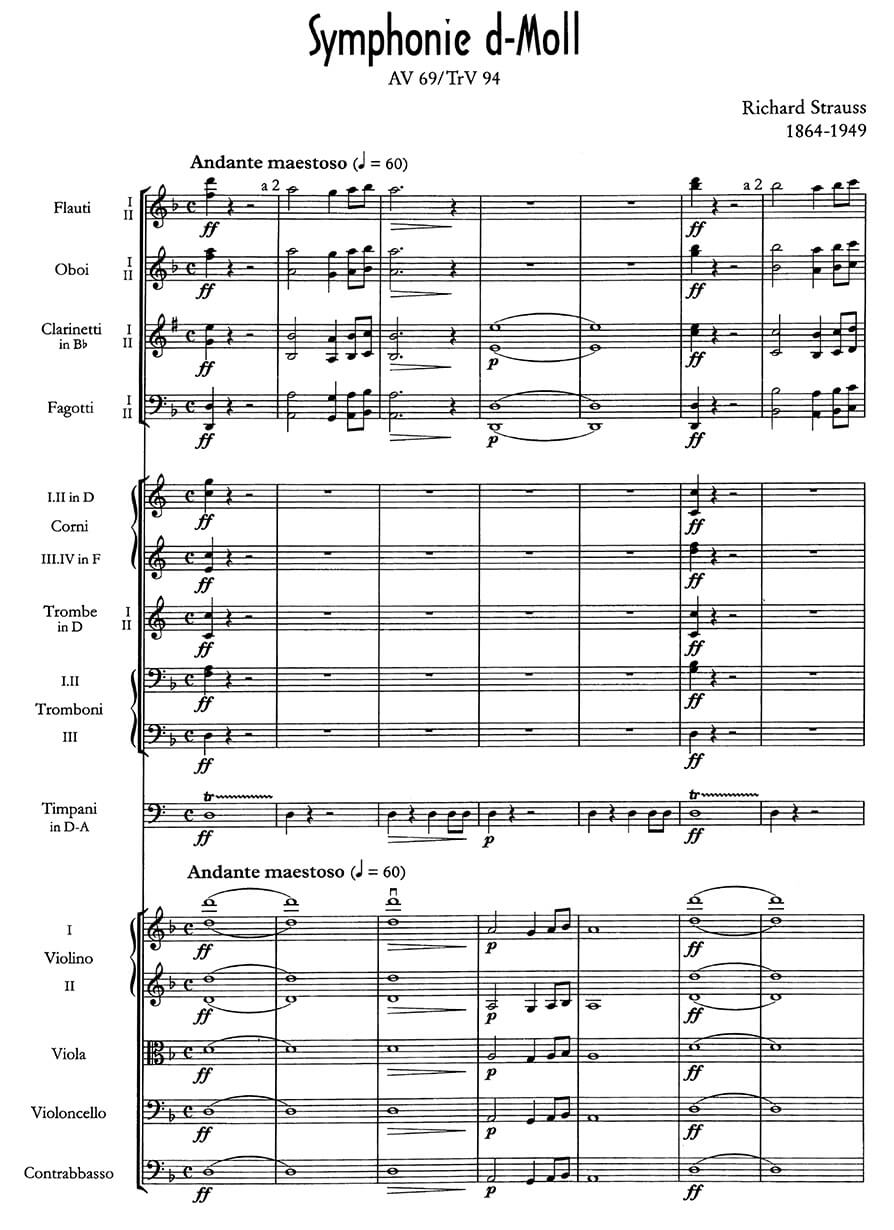Symphony in D minor WoO 69 TrV 94
Strauss, Richard
35,00 €
Richard Strauss – Symphony in D minor WoO 69 TrV 94
(b. Munich, 11 June 1864 – d. Garmisch-Partenkirchen, 8 September 1949
Preface
The autograph score of Richard Strauss’ first surviving symphony, which he even considered giving an opus number (4) in the meantime, was completed on 17 October 1880. The premiere, relatively soon afterwards on 30 March 1881 in Munich’s Odeonssaal, was conducted by none other than Hermann Levi. The work was more than just a respectable success; the Münchner Neueste Nachrichten reported: “In the third subscription concert of the Musikalische Akademie, we heard a symphony by Richard Strauss in D minor as a novelty. On the occasion of the performance of his string quartet, we had already drawn attention to the significant talent of the composer, who was still at such a young age; the symphony also shows a very significant dexterity in the handling of the form and decisive skilfulness in the orchestration. However, this work does not yet reflect any real originality. But it shows in all parts a musical fantasy activity that is reproduced with great ease.”
However, after completing his Symphony in F minor op. 12, he distanced himself from his first work even before its premiere; he wrote to his father on 11 February 1884: “Dear Dad! (…) I beg you not to send my first symphony anywhere, as I do not wish it to be performed.” The manuscript disappeared into the family archives, and only one further performance during Strauss’s lifetime is documented (on 5 January 1893). It was performed by the “Wilde Gung’l” orchestra association in Munich, to which Strauss gave the sole performance rights. Franz Strauss senior, who conducted this performance as chief conductor of the orchestra association, produced an ink copy for this purpose, also still with the opus number 4, although the composer had already reassigned this opus number in September 1884. The work was not printed until 1980. In his copy, Franz Strauss Sr. changed the movement designations as follows:
I. (composed 12 March to 8 April 1880): Andante maestoso (M.M. =60) – Allegro
(M.M. =66) instead of Andante – Allegro vivace;
II. (composed until 3 May): Andante (M.M. =52) instead of Adagio ma non troppo;
III. (composed from 3 to 15 May): Scherzo. Molto allegro, leggiero – Trio (M.M. =92)
instead of Scherzo – Trio;
IV. (completed 12 June 1880): Finale. Allegro maestoso (M.M. =132) instead of Allegro con brio.
In his younger years, Strauss still followed the traditional formal concepts quite strictly, both in the D minor and the F minor symphonies. Nonetheless, he often surprises us with various tricks (which, however, do not fall outside the usual framework), in the first movement of the Symphony in D minor, for example, with a certain interweaving of exposition and development. The slow movement can be interpreted as a variative verse form, also as a sonata form without development in A major. The first half of the movement (mm. 1-50) is repeated in the second half (mm. 51-112), sometimes with very minor changes. Here, the entire thematic material is derived from two main themes, between which there is again a substantial relationship. Here we also find (mm 94-95) a genuinely Schumannian stylistic device, the octave of the flute despite its lack of necessity. The Scherzo, which combines the influences of Mendelssohn and Schumann, is also substantially related to the first and thus also to the second movement. The finale is once again a sonata form movement, this time with the special feature that the development leads into a fugue from which the recapitulation begins (a very similar technique can be found in the Symphonia Domestica). Strauss’s first biographer and school friend Max Steinitzer summarised the characteristics of the work as follows: “A high degree of maturity, formal fluency and a sense of melodiousness are expressed in the whole, at the same time an intense seriousness, turned away from all triviality, most closely related to the style of Schumann.”1
Jürgen Schaarwächter, 2024
Max Steinitzer: Richard Strauss. Biographie, Berlin/Leipzig 1911, p. 33. The only detailed analytical consideration of the D minor Symphony can be found in Jürgen Schaarwächter, Richard Strauss und die Sinfonie, Cologne 1994, pp. 12-23.
Performance material is available from Schott, Mainz
Vorwort Deutsch … > HERE
| Score Number | 4863 |
|---|---|
| Edition | Repertoire Explorer |
| Genre | Orchestra |
| Pages | 148 |
| Size | |
| Printing | Reprint |
